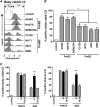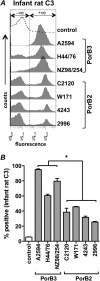Inhibition of the alternative pathway of nonhuman infant complement by porin B2 contributes to virulence of Neisseria meningitidis in the infant rat model
- PMID: 24686052
- PMCID: PMC4019150
- DOI: 10.1128/IAI.01517-14
Inhibition of the alternative pathway of nonhuman infant complement by porin B2 contributes to virulence of Neisseria meningitidis in the infant rat model
Abstract
Neisseria meningitidis utilizes capsular polysaccharide, lipooligosaccharide (LOS) sialic acid, factor H binding protein (fHbp), and neisserial surface protein A (NspA) to regulate the alternative pathway (AP) of complement. Using meningococcal mutants that lacked all four of the above-mentioned molecules (quadruple mutants), we recently identified a role for PorB2 in attenuating the human AP; inhibition was mediated by human fH, a key downregulatory protein of the AP. Previous studies showed that fH downregulation of the AP via fHbp or NspA is specific for human fH. Here, we report that PorB2-expressing quadruple mutants also regulate the AP of baby rabbit and infant rat complement. Blocking a human fH binding region on PorB2 of the quadruple mutant of strain 4243 with a chimeric protein that comprised human fH domains 6 and 7 fused to murine IgG Fc enhanced AP-mediated baby rabbit C3 deposition, which provided evidence for an fH-dependent mechanism of nonhuman AP regulation by PorB2. Using isogenic mutants of strain H44/76 that differed only in their PorB molecules, we confirmed a role for PorB2 in resistance to killing by infant rat serum. The PorB2-expressing strain also caused higher levels of bacteremia in infant rats than its isogenic PorB3-expressing counterpart, thus providing a molecular basis for increased survival of PorB2 isolates in this model. These studies link PorB2 expression with infection of infant rats, which could inform the choice of meningococcal strains for use in animal models, and reveals, for the first time, that PorB2-expressing strains of N. meningitidis regulate the AP of baby rabbits and rats.
Figures




Similar articles
-
Binding of complement factor H to PorB3 and NspA enhances resistance of Neisseria meningitidis to anti-factor H binding protein bactericidal activity.Infect Immun. 2015 Apr;83(4):1536-45. doi: 10.1128/IAI.02984-14. Epub 2015 Feb 2. Infect Immun. 2015. PMID: 25644002 Free PMC article.
-
Factor H-dependent alternative pathway inhibition mediated by porin B contributes to virulence of Neisseria meningitidis.mBio. 2013 Oct 15;4(5):e00339-13. doi: 10.1128/mBio.00339-13. mBio. 2013. PMID: 24129254 Free PMC article.
-
The relative roles of factor H binding protein, neisserial surface protein A, and lipooligosaccharide sialylation in regulation of the alternative pathway of complement on meningococci.J Immunol. 2012 May 15;188(10):5063-72. doi: 10.4049/jimmunol.1103748. Epub 2012 Apr 13. J Immunol. 2012. PMID: 22504643 Free PMC article.
-
Role of factor H binding protein in Neisseria meningitidis virulence and its potential as a vaccine candidate to broadly protect against meningococcal disease.Microbiol Mol Biol Rev. 2013 Jun;77(2):234-52. doi: 10.1128/MMBR.00056-12. Microbiol Mol Biol Rev. 2013. PMID: 23699256 Free PMC article. Review.
-
Does binding of complement factor H to the meningococcal vaccine antigen, factor H binding protein, decrease protective serum antibody responses?Clin Vaccine Immunol. 2013 Aug;20(8):1099-107. doi: 10.1128/CVI.00260-13. Epub 2013 Jun 5. Clin Vaccine Immunol. 2013. PMID: 23740919 Free PMC article. Review.
Cited by
-
Resistance of Neisseria meningitidis to human serum depends on T and B cell stimulating protein B.Infect Immun. 2015 Apr;83(4):1257-64. doi: 10.1128/IAI.03134-14. Epub 2015 Jan 12. Infect Immun. 2015. PMID: 25583528 Free PMC article.
-
Genetic variants linked to the phenotypic outcome of invasive disease and carriage of Neisseria meningitidis.Microb Genom. 2023 Oct;9(10):001124. doi: 10.1099/mgen.0.001124. Microb Genom. 2023. PMID: 37874326 Free PMC article.
-
Breadth and Duration of Meningococcal Serum Bactericidal Activity in Health Care Workers and Microbiologists Immunized with the MenB-FHbp Vaccine.Clin Vaccine Immunol. 2017 Aug 4;24(8):e00121-17. doi: 10.1128/CVI.00121-17. Print 2017 Aug. Clin Vaccine Immunol. 2017. PMID: 28566335 Free PMC article.
-
How the Knowledge of Interactions between Meningococcus and the Human Immune System Has Been Used to Prepare Effective Neisseria meningitidis Vaccines.J Immunol Res. 2015;2015:189153. doi: 10.1155/2015/189153. Epub 2015 Aug 17. J Immunol Res. 2015. PMID: 26351643 Free PMC article. Review.
-
Binding of complement factor H to PorB3 and NspA enhances resistance of Neisseria meningitidis to anti-factor H binding protein bactericidal activity.Infect Immun. 2015 Apr;83(4):1536-45. doi: 10.1128/IAI.02984-14. Epub 2015 Feb 2. Infect Immun. 2015. PMID: 25644002 Free PMC article.
References
-
- Austen KF, Fearon DT. 1979. A molecular basis of activation of the alternative pathway of human complement. Adv. Exp. Med. Biol. 120B:3–17 - PubMed
Publication types
MeSH terms
Substances
Grants and funding
- R37 AI032725/AI/NIAID NIH HHS/United States
- R21 AI111728/AI/NIAID NIH HHS/United States
- R56 AI032725/AI/NIAID NIH HHS/United States
- AI082263/AI/NIAID NIH HHS/United States
- R01 AI046464/AI/NIAID NIH HHS/United States
- AI054544/AI/NIAID NIH HHS/United States
- U19 AI084048/AI/NIAID NIH HHS/United States
- AI046464/AI/NIAID NIH HHS/United States
- L40 AI057605/AI/NIAID NIH HHS/United States
- AI084048/AI/NIAID NIH HHS/United States
- R01 AI082263/AI/NIAID NIH HHS/United States
- C06 RR016226/RR/NCRR NIH HHS/United States
- R01 AI032725/AI/NIAID NIH HHS/United States
- AI32725/AI/NIAID NIH HHS/United States
- R01 AI054544/AI/NIAID NIH HHS/United States
LinkOut - more resources
Full Text Sources
Other Literature Sources
Medical
Miscellaneous

